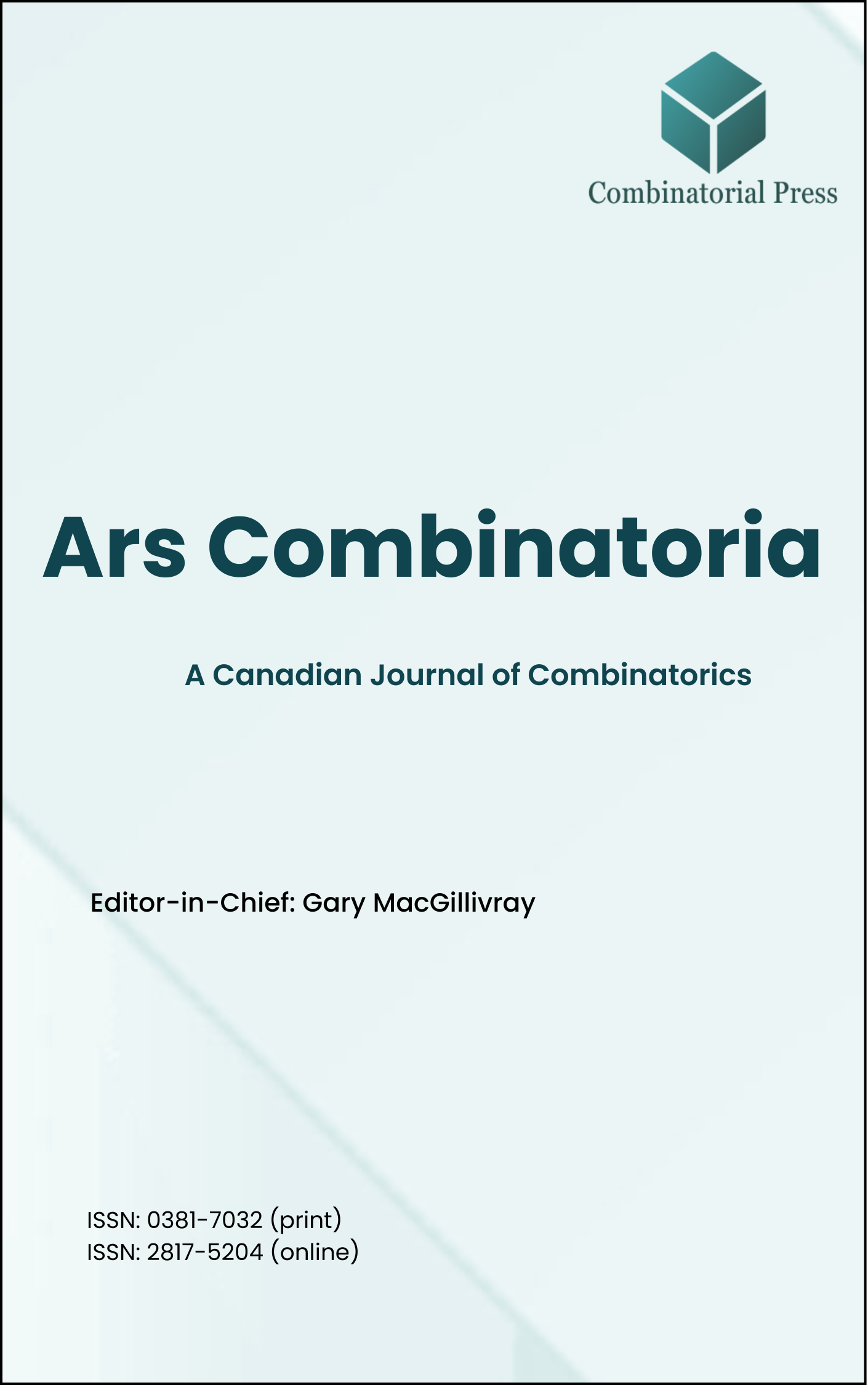
Ars Combinatoria
ISSN 0381-7032 (print), 2817-5204 (online)
Ars Combinatoria is the oldest Canadian Journal of Combinatorics, established in 1976. The journal is dedicated to advancing the field of combinatorial mathematics through the publication of high-quality research papers. From 2024 onward, it publishes four volumes per year in March, June, September and December. Ars Combinatoria has gained recognition and visibility in the academic community and is indexed in renowned databases such as MathSciNet, Zentralblatt, and Scopus. The Scope of the journal includes Graph theory, Design theory, Extremal combinatorics, Enumeration, Algebraic combinatorics, Combinatorial optimization, Ramsey theory, Automorphism groups, Coding theory, Finite geometries, Chemical graph theory but not limited.
Information Menu
- Research article
- Full Text
- Ars Combinatoria
- Volume 036
- Pages: 47-56
- Published: 31/12/1993
A decomposition of \(K_v\) into \(2\)-perfect \(8\)-cycles is shown to exist if and only if \(v \equiv 1 (\mod 16\)).
- Research article
- Full Text
- Ars Combinatoria
- Volume 036
- Pages: 33-46
- Published: 31/12/1993
The binary matroids with no three- and four-wheel minors were characterized by Brylawski and Oxley, respectively. The importance of these results is that, in a version of Seymour’s Splitter Theorem, Coullard showed that the three- and four-wheel matroids are the basic building blocks of the class of binary matroids. This paper determines the structure of a class of binary matroids which almost have no four-wheel minor. This class consists of matroids \(M\) having a four-wheel minor and an element \(e\) such that both the deletion and contraction of \(e\) from \(M\) have no four-wheel minor.
- Research article
- Full Text
- Ars Combinatoria
- Volume 036
- Pages: 27-31
- Published: 31/12/1993
- Research article
- Full Text
- Ars Combinatoria
- Volume 036
- Pages: 7-26
- Published: 31/12/1993
A pairwise balanced design (PBD) of index \(I\) is a pair \((V,{A})\) where \(V\) is a finite set of points and \(A\) is a set of subsets (called blocks) of \(V\), each of cardinality at least two, such that every pair of distinct points of \(V\) is contained in exactly one block of \(A\). We may further restrict this definition to allow precisely one block of a given size, and in this case the design is called a PBD \((\{K, k^*\},v)\) where \(k\) is the unique block size, \(K\) is the set of other allowable block sizes, and \(v\) is the number of points in the design.
It is shown here that a PBD \((\{5, 9^*\},v)\) exists for all \(v \equiv 9\) or 17 mod 20, \(v \geq 37\), with the possible exception of \(49\), and that a PBD \((\{5, 13^*\},v)\) exists for all \(v \equiv 13 \mod 20\), \(v \geq 53\).
- Research article
- Full Text
- Ars Combinatoria
- Volume 036
- Pages: 3-6
- Published: 31/12/1993
A partition \(\mathcal{D} = \{V_1, \ldots, V_m\}\) of the vertex set \(V(G)\) of a graph \(G\) is said to be a star decomposition if each \(V_i\) (\(1 \leq i \leq m\)) induces a star of order at least two.
In this note, we prove that a connected graph \(G\) has a star decomposition if and only if \(G\) has a block which is not a complete graph of odd order.
- Research article
- Full Text
- Ars Combinatoria
- Volume 035
- Pages: 335-349
- Published: 30/06/1993
A graph \(G\) is a sum graph if there is a labeling \(o\) of its vertices with distinct positive integers, so that for any two distinct vertices \(u\) and \(v\), \(uv\) is an edge of \(G\) if and only if \(\sigma(u) +\sigma(v) = \sigma(w)\) for some other vertex \(w\). Every sum graph has at least one isolated vertex (the vertex with the largest label). Harary has conjectured that any tree can be made into a sum graph with the addition of a single isolated vertex. We prove this conjecture.
- Research article
- Full Text
- Ars Combinatoria
- Volume 035
- Pages: 325-333
- Published: 30/06/1993
An \(H\)-decomposition of a graph \(G\) is a representation of \(G\) as an edge disjoint union of subgraphs, all of which are isomorphic to another graph \(H\). We study the case where \(H\) is \(P_3 \cup tK_2\) – the vertex disjoint union of a simple path of length 2 (edges) and \(t\) isolated edges – and prove that a set of three obviously necessary conditions for \(G = (V, E)\) to admit an \(H\)-decomposition, is also sufficient if \(|E|\) exceeds a certain function of \(t\). A polynomial time algorithm to test \(H\)-decomposability of an input graph \(G\) immediately follows.
- Research article
- Full Text
- Ars Combinatoria
- Volume 035
- Pages: 315-323
- Published: 30/06/1993
In this paper we consider group divisible designs with equal-sized holes \((HGDD)\) which is a generalization of modified group divisible designs \([1]\) and \(HMOLS\). We prove that the obvious necessary conditions for the existence of the \(HGDD\) is sufficient when the block size is three, which generalizes the result of Assaf[1].
- Research article
- Full Text
- Ars Combinatoria
- Volume 035
- Pages: 303-313
- Published: 30/06/1993
An obvious necessary condition for the existence of an almost resolvable \(B(k,k-1;v)\) is \(v \equiv 1 \pmod{k}\). We show in this paper that the necessary condition is also sufficient for \(k = 5\) or \(k = 6\), possibly excepting \(8\) values of \(v\) when \(k = 5\) and \(3\) values of \(v\) when \(k = 6\).
- Research article
- Full Text
- Ars Combinatoria
- Volume 035
- Pages: 291-302
- Published: 30/06/1993





